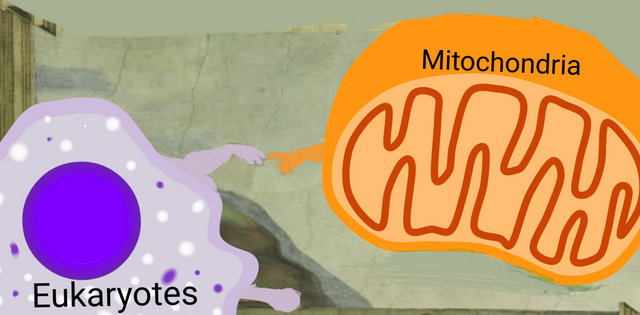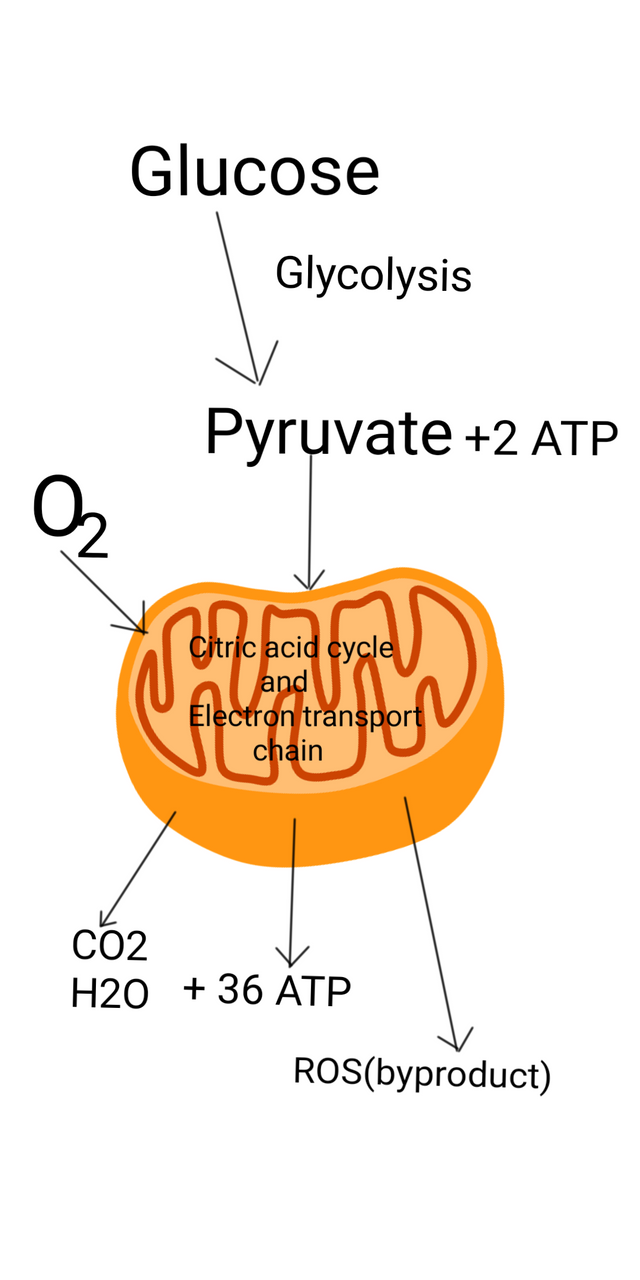The quest for elixir of life - understanding caloric restriction (episode 2 - mitochondria)
Made by using following images
Creation of Adam by Michaelangelo | Public Domain
Macrophage by A. Rad, Mikael Häggström, Spacebirdy, RexxS, domdomegg| CC BY-SA 4.0
Mitochondria by openclipart-vectors | pixabay
About 2.7 billion years ago, the earth was flourishing with life. Some bacteria and archaea floating in the waters. Life have just discovered to use sunlight and carbondioxide in the air to make its own food. They were pumping oxygen into the atmosphere. But oxygen was toxic, very toxic. But, life doesn't give up so easily. It found a way to use this oxygen for its own benefit. We were not there to witness our creation but on one of those days another prokaryote or a cell that has already evolved nucleus met this bacteria. The one that could use food produced by others and oxygen from the atmosphere to make energy. This bacteria and the other cell made pact, to stay together for eternity. The eukaryotic cell will provide it food, protection and well also carry some of its genes. The bacteria in return will provide the energy in form of numerous ATP molecules. This will mark the history of all the eukaryotes, even multicellular eukaryotes like us. We all carry this bacteria in our cells, we now call it mitochondria. Passed on from mother to the child. It makes energy for all the cellular processes. But, it also does something else as a side effect. It contributes to ageing. And in this episode we will explore how.
Recap
In the previous episode, in our quest for elixir of life - we encountered the DNA damage, that accumulate through our life. We figured that caloric restriction reduced the damage. We saw that, it achieves this feat by activating DNA repair pathways, which seem to be downregulated with ageing otherwise. We also saw two drugs - rapamycin and resveratol (the compound found in red wine) reduces DNA damage, and increases lifespan. However, what we did not see is how if caloric restriction works upstream of DNA damage? Does it reduce the damage causing factors itself? What about other damage endured by the tissues?
In this episode, we will look at the cellular metabolism angle of caloric restriction. We will focus on this cell organelle called mitochondria and ask how it contributes to ageing and what is affect if caloric restriction on it.
How mitochondria contributes to ageing
Mitochondria by openclipart-vectors | pixabay
The mitochondria, popularly known as power house of the cell is responsible for producing energy for cellular processes. When glucose enters the cell it is broken down to pyruvate by glycolysis , giving us only tiny portion of energy. But then this pyruvate is taken up by mitochondria and is passed through series of enzymes in citric acid cycle. This is where electrons from food is transferred to oxygen, yielding carbon dioxide and water as by product. The energy yielded by this reaction is eventually used by enzyme called ATP synthase, which makes most of ATP molecules for energy requirement of cells.
Oxidative stress and cellular damage
But, the system is not free of creating byproducts. The electrons tend to leak from electron transport chain in mitochondria and end up giving rise to superoxide and hydrogen peroxide - the reactive oxygen species (ROS). Though, ROS comes handy at times - it participates in many signalling pathways, it can protect against pathogens, and activate autophagy and apoptosis during cellular stress - it also damages many macromolecules. No macromolecule, be it DNA, protein or lipids is spared by damage caused by ROS.
Given the damaging effect of ROS one might expect that, many of the damages caused by ROS are repaired but some of it accumulate over time in mitochondrial DNA and in cells. This would put ROS upstream of the oxidative DNA damage that we saw in previous blog. And, add to that the age dependent decrease in DNA repair capacity. It has also been reported that mitochondrial function declines with age, leading to low efficiency of energy production and increased ROS production. For instance, kuka et al., 2013 showed mitochondria of heart cells of an old rat produces much more ROS than young heart cells. Moreover, macrophages responding to injury old animals produce much higher amount of ROS than younger animals (Zhang et al., 2016). At the end of the day the job of scavenging ROS comes to enzymes such as Superoxide dismutase and catalase. The expression and efficiency of these enzymes have also shown to affected by ageing.
Beyond oxidative stress
Now, ROS may not be the only way by which mitochondria may contributes to aging. The favorite hypothesis for ageing few years back was that mitochondria produces ROS, which causes mitochondrial DNA damage, which causes it to produce even more ROS in a vicious cycle. But with time we are learning that DNA mutations arise independent of ROS as well, moreover over expression of enzymes that protect against oxidative damage doesn't always extend life span (Gladyshev, 2014). It is possible that while ROS does cause damage to molecules, but cells evolved to also an important signaling molecules. Also, low level of ROS may act like a vaccine, which keeps the wheel of antioxidant enzymes and turing on autophagy to get rid of damaged mitochondria. But, high levels might escape those check point and induce damage. The turnover and morphology of mitochondria is equally important. There is also an age related accumulation of abnormally shaped and giant mitochondria. This is likely to be byproduct of reduced regulation of mitochondrial fission/fusion, degradation and biogenesis. Whether these abnormalities are linked with ROS and it's increased production with age remains to be tested. These abnormalities may however increase cell death by apiptosis and hinder stem cell homeostasis (Seo et al., 2010, Zhang et al., 2018).
Given the above information, it becomes interesting to question that how the well known elixir of life - caloric restriction affects mitochondria. And, can we develop drugs that could mimic those affects.
Caloric restriction and mitochondria
Lopez-Lluch et al., 2006 demonstrated that caloric restriction has multiple effects on mitochondria. It increases the efficiency of energy production by mitochondria, while at the same time reduces ROS production and increases mitochondrial biogenesis. If this is true we can start testing if any of these mechanisms induced artificially can also extend lifespan?
Exogenous anti-oxidants
Image from MaxPixel | CC0
The first thing comes to mind is to feed the animals or humans with antioxidants, such as vitamin C and E, and see if it extends lifespan, or at least reduce some age related maladies. Studies in model organisms have yielded mixed results. Some showed promising life span extension effect of vitamin C, E and melatonin, while others show no effect and even negative in some cases. From studies where it works it seems there are at least two important factors for it to work. The window of intervention being most important. Then the how was the supplement given also matters. For instance giving vitamin C via simple oral route did not work as well, but giving it after packing it in liposomes did the trick. Then most interesting part of mice studies where it worked is that, in many of these studies it increased the median or mean lifespan, but did not affect maximum lifespan. This hints that while scavenging ROS by antioxidants keeps some age related diseases away, it does not do much to push the bar. It does not slow down the basal level of decay, that causes ageing (see Bartosz and Bartosz, 2014 for more details on antioxidant studies). As far as humans are concerned synergy is the key. Vitamin E alone did not help much in one of the large follow up human study. Well, at least it did not help men who between 60-70 years of age. But those crossing this 70 years line it increased life span by 2 years and decreased mortality by 24%. But here is the catch, it was beneficial to only those who smoked less and had good dietary intake of vitamin C.
Throws pack of cigarettes out of the window, and goes shopping for citrus fruits, nuts and green leafy veggies
Mitochondrial biogenesis
Nevertheless, it has been demonstrated in vivo and in vitro, that caloric restriction preserves the mitochondrial biogenesis (see Picca et al., 2013). And it seems to be upstream of ROS production. Which means new mitochondria are less likely to cause oxidative damage to begin with (and also less likely to interfere with stem cell pool). In this regard, the mitochondrial biogenesis is under the control of protein called PGC1-alpha. This protein is downstream of sirtuins and AMPK. If you recall from previous episode then sirtuin activation protected against DNA damage. Looks like sirtuins are doing more than just helping with DNA damage. So what if we could activate srtuins and AMPK by other methods?
How about exercise and red wine?
Image by MaxPixel | CC0
Exercise is another method that is known to stimulate mitochondrial biogenesis via activation of sirtuins and AMPK. Exercise along with CR is known for its lifespan extension effects. But what about reseveratol (that thing in red wine)? Activation of Sirtuins by Reserveratol is disputed and seem to be an experimental artifact. But nevertheless it does seem that resveratol can activate AMPK and sirtuins by indirect route. Resveratol causes glucagon and catecholamine release in the body. These hormones causes elevated calcium levels in cells which leads to AMPK activation. Then in presence of high NAD+ in cells AMPK leads to activation of SIRT1. The pathway eventually leads to activation of mitochondrial biogenesis by PGC1-alpha. Moreover, resveratol is also acts as antioxidant (see Madreiter-Sokolowski, 2018).
Grabs red wine! But wait, alcohol is toxic having too much of it may be rather counter productive.
Another way to induce mitochondrial biogenesis is by omega-3 fatty acids. It does so by activating a protein called NRF2 and extends lifespan of worms (see Qi et al., 2017). NRF1 and 2 are downstream of PGC1a (see Austin and St-Pierre, 2012. This is inline with human study where omega 3 fatty acids reduced oxidative stress (Laila et al., 2017).
So, maybe some fish, wine, green leafy veggies and exercise then? Sounds like a plan, eh! Worth a shot, at least?
The wonder of metformin
Ok, I am not gonna bug you a lot. I have a lot to say, but maybe we can stop with discussion of effect of insulin pathway on mitochondria for today. Well one of the pathway involved in lifespan extension by caloric restriction is - insulin/insulin like growth factor pathway. In fact giving exogenous insulin during caloric restriction can reverse the good things that happen to mitochondria (Lambert et al., 2004). And then having diet rich in sugar, esp those super sugar syrups we have as sodas, decreases lifespan. We can actually have a separate episode on sugar, insulin and ageing some other time. However, what is interesting to be noted that the well known diabetic drug - metformin also acts an anti-ageing drug, in animal models and in humans (Valencia et al., 2017). It turns out that among other things metformin activates AMPK and also inhibit mTOR pathway (another pathway we discussed in lifespan extension that we discussed in previous episode).
Closing remarks
Well, I think this should be enough for today. I have not gotten into details of mitochondrial fission and fusion dynamics in ageing. In case you are interested, look that up. I know that this episode was supposed to be about immuno-metabolism. But, then I thought it would be unjust to jump to immune cells without talking a bit about metabolism. So in next chapter, we will talk about role of inflammation in ageing and we may revisit bit of metabolism, yet again. In the meantime we can discuss this topic further in comments.
About steemstem
But, before I go I would like to mention about the steemstem platform. Well, if you love reading and writing interesting science articles @steemstem is a community on steem that support authors and content creators in STEM field. If you wish to support steemstem do see the links below.
You can vote for steemstem witness here -Quick link for voting for the SteemSTEM Witness(@stem.witness)
Quick delegation links for @steemstem
50SP | 100SP | 500SP | 1000SP | 5000SP | 10000SP).
Delegating to @steemstem gives ROI of 65% of the curation rewards.
Also, if you have any questions regarding steemstem, do join the steemstem discord server.
You can DM me on discord, I have the same handle - @scienceblocks.
References
The quest for elixir of life - understanding caloric restriction (episode 1 - DNA damage and repair)
Zhang et al., 2018. The role of mitochondria in stem cell fate and aging
Signing off
@scienceblocks


.jpeg)

Excellent post, thank you! Definitely got you a new follower! i will go get some red wine now ;)
I’ve been following and you have great posts!
Sometimes my body just feels like I can’t eat, so I fast about 4-6 days/month. Looking forward to hear what you have to say about fasting.
Glad to see this series continue. Cool to know that anti-oxidants increase average lifespan, but it may be difficult to say it's because of the antioxidant aspect of some of those vitamins (like vitamin C) which can play important roles in other metabolic functions.
Of course, it can have other off target affects, which may cause the same result.
Posted using Partiko Android
Hey @scienceblocks,
nice pictures this time and even more interesting facts.
Thank you for this... resteem!
By the way: In the case of metformin it was postulated that it triggers the production of "beneficial" ROS in low doses which in turn activates NRF2/Kap1 as well as PGC1a. This mechanism is called "mitohermesis".
It probably is the same effect you have after sports.
Regards
Chapper
Very informative! Did you find any numbers on recommended caloric intake that would still fall under caloric restriction?
Well, in animal studies the caloric restriction was upto 50% of baseline intake. But you have to be careful you don't want to starve yourself. In human clinical trials the caloric restriction achieved was about 15-25% (Redman et al., 2018. Based on this study I would say cutting off calories by 15% of daily requirement should be safe. Also, it is to be noted that most of experimentally controlled diets also did take care of nutritional value of components fed to animals. And as it is seen two separate primate studies food composition is also likely to play a role, even when caloric density is maintained the same. So it's good to make sure that appropriate vitamins and micronutrients are going in, along with proper composition of micronutrients. Of course this is still developing branch of caloric restriction regime, and we will know more with time.
Posted using Partiko Android
It’s a lot to take in but I love hearing you theories on how to slow down aging.
Hi @scienceblocks!
Your post was upvoted by @steem-ua, new Steem dApp, using UserAuthority for algorithmic post curation!
Your UA account score is currently 3.040 which ranks you at #9890 across all Steem accounts.
Your rank has improved 570 places in the last three days (old rank 10460).
In our last Algorithmic Curation Round, consisting of 227 contributions, your post is ranked at #173.
Evaluation of your UA score:
Feel free to join our @steem-ua Discord server
This post has been voted on by the SteemSTEM curation team and voting trail. It is elligible for support from @curie and @utopian-io.
If you appreciate the work we are doing, then consider supporting our witness stem.witness. Additional witness support to the curie witness and utopian-io witness would be appreciated as well.
For additional information please join us on the SteemSTEM discord and to get to know the rest of the community!
Thanks for having added @steemstem as a beneficiary to your post. This granted you a stronger support from SteemSTEM.
Thanks for having used the steemstem.io app. You got a stronger support!
Congratulations @scienceblocks! You have completed the following achievement on the Steem blockchain and have been rewarded with new badge(s) :
You can view your badges on your Steem Board and compare to others on the Steem Ranking
If you no longer want to receive notifications, reply to this comment with the word
STOPHi @scienceblocks!
Your post was upvoted by Utopian.io in cooperation with @steemstem - supporting knowledge, innovation and technological advancement on the Steem Blockchain.
Contribute to Open Source with utopian.io
Learn how to contribute on our website and join the new open source economy.
Want to chat? Join the Utopian Community on Discord https://discord.gg/h52nFrV